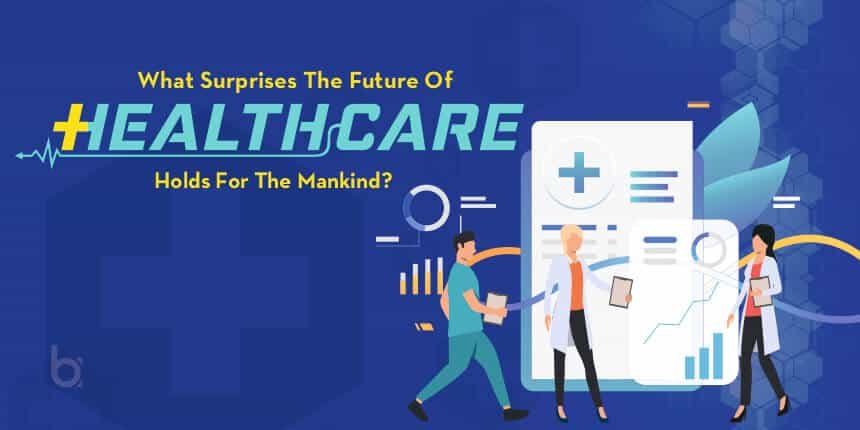The growth in technology innovations is incredible. These innovations are crafting and shaping the future with a beneficial outcome. Medical industry also seems to take advantage of the growing technology. The line between the technical industry and healthcare is blurred due to the new inventions. This new technology will be proven beneficial for the future of the healthcare industry too. With combination of upgraded tech and healthcare can help cure diseases more rapidly. To explain it further, cancer has been a threat to humans for a long time. Many times the detection takes a long time which proves harmful and may result sometimes in death but, what if there is tech invented which could predict the rise of cancer cells in the early stages and cures it before it starts acting upon?
Many future techs are working on overcoming life-threatening diseases and making it easier to come up with a cure. The future of healthcare seems brighter with the constant efforts taken towards upgrading technology. Where people think that technology will prove harmful for humanity, the future holds the opposite of it. AI and robotics would work collaboratively with humans to prove the best combination for an enhanced future of healthcare.
Some of the innovations are already emerging with rapid growth and may be used soon. These innovations are still at an early stage but give a good interpretation of how the future of healthcare would look.
We can predict new changes in the way of treatment and brace ourselves for a better replacement of diagnosis. Below listed are some of the upcoming technologies which would remold the future of healthcare.
Dementia – not to be forgotten
One of the leading causes of death is dementia— the most common form of Alzheimer’s disease. With the rise in the average population, the death rate is also likely to rise. Even with all the research, catching dementia early seems to be a challenge. However, Oxford Brain Diagnostics believes that their technology may change this, as it can detect the condition even before the symptoms become recognizable. Their technology enables scientists to gather an extra level of detail from existing MRI scans. This technique depends on the cortical disarray measurement (CDM), which allows them to detect changes in the microanatomy of the brain.
The CEO of Oxford Brain Diagnostics stated that the CDM extracts information about the microscopic structure of the brain’s gray matter by applying a unique analysis to a standard MRI scan.
Along with the obvious benefit of spotting the signs of dementia early, the technology might also help the pharmaceutical industry to measure how experimental drugs affect the microstructure of the brain.
Are ‘Smart screens’ smart enough to cure cancer?
Around 90 percent of deaths from cervical cancer occur in low and middle-income societies. In last year, 570,000 new cases of cervical cancer were detected. In such scenarios, better screening and earlier detection could remarkably reduce the death rate.
MobileODT has designed a battery-operated, hand-held colposcope called the EVA System, which takes high-quality images of the cervix.
The National Cancer Institute worked with MobileODT to develop a machine learning algorithm, called automatic visual evaluation, which can produce an accurate diagnosis in minutes. With the studies conducted in Korea, the device has an accuracy rate of more than 90 percent.
The notable feature about the device is that its handheld technology which can be used by any non-expert healthcare provider. The device is based on a smartphone technology; it is user-friendly and also includes a remote consultation which would allow the user to consult the experts in real-time or during assurance check.
With this technology, the detection and treatment would start earlier, rather than waiting several months for the results and then acting upon them.
An eye for an eye
The bionic eye is a visual prosthetic, which is yet an experiment carried out to restore the partial or total visual impairment. To explain it in simpler words, it is just like an eye replacement to restore your vision.
Creating a bionic eye has many challenges, but the researchers may have just solved one of them. With the use of 3D technology, they printed an array of light receptors on a glass eye-shaped object. The silver particles they used as “ink” stayed at the place, despite the curved surface, and the photodiodes converted light into electricity with 25 percent efficiency. New improvements are required because even though with all the changes, the bionic eye is still not usable. With more light receptors and a softer surface, it would make the implant more comfortable.
The future Nano-Tech and Wearables
The new trend of fitness bands doesn’t only cover the fitness factor but is also trendy. With the use of this technology, one could monitor the heartbeats and keep a track of fitness. In the future, these gadgets would help the users to monitor and feed the fitness activities which would detect the diseases in the early stages and prevent them from occurring or at least worsening.
Smart nano techs like the hearing aids or earbuds can be upgraded to track heart rate and movement, with an integrated addition of a guide for the assistance of a dementia patient.
Contact lenses will be combined with thousands of biosensors and engineered to identify the early stages of cancer and other diseases. Smart lenses may also help in measuring blood sugar values in tears, to help diabetics keep a track of their health and medications.
Implantable devices can be used to hold medical records of a patient or a sensor that would constantly measure the vitals. These devices might include a radio-frequency chip and will be placed under the skin. Additionally, indigestible devices that are…… will be shaped like a capsule, which when swallowed would unfold into a nanochip that will perform the task in the gastrointestinal system. These breakthrough features would not only deliver treatment but also withdraw any unfamiliar object.
A selfie a day will keep the disease away
An app developed at the University of Washington could help identify pancreatic cancer by examining the whites of eyes for signs of jaundice. Snap a selfie and the app would use it to identify the increased bilirubin levels, which is a possible symptom of the disease. These photos can also help dermatologists identify the skin spot and provide the needed cure for it. The app uses a smartphone camera with computer vision which will store the data and analyse it to come up with required precautions and solutions.
Technology is coming up with new inventions daily to help survive humanity against the diseases. The machine recorded data is more accurate than the data noted by humans. A prediction of the future of the device is noteworthy. The efforts taken by the scientist are great but it is also important that these techs reach people. The technology developed is easily accessible to those willing to pay a hefty amount but the people who cannot afford the luxuries are deprived of the benefit. Today many low- and middle-income people cannot afford the treatment due to the lack of healthcare. The future of healthcare should also focus on the problem where people are not being able to access the goods. Inventing new resources is only beneficial when the resources reach people in need.

















